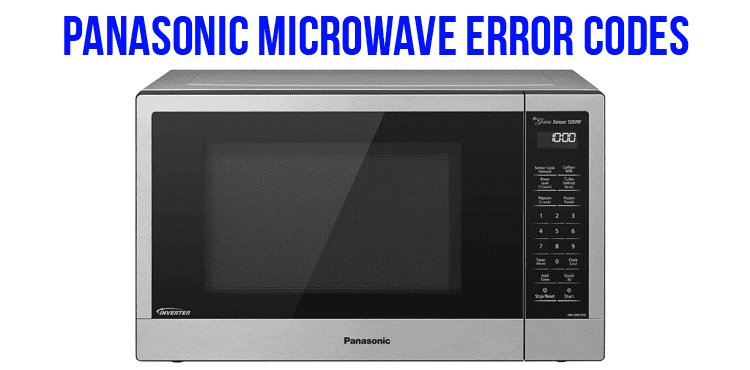
Microwaves have become an essential part of our daily lives, acting like our silent kitchen assistants. They warm up leftovers, defrost frozen goodies, and even help whip up quick meals. So, when an error code like OE pops up, it can feel like your trusty assistant just went on strike. Essentially, the OE error code is Panasonic’s way of telling you there’s a problem with how the microwave door is closing. It’s like when your car’s dashboard lights up to remind you that something needs your attention.
Understanding the OE Error Code
When your Panasonic microwave flashes the OE error code, it’s trying to communicate that there’s a door-related issue at hand. Think of it as your microwave’s way of saying, “Hey, I need my door to be closed properly to operate safely.” The door interlock system is like a security guard for your microwave, ensuring that the microwave won’t start cooking unless everything is safely sealed. This feature is crucial because it prevents microwaves from leaking out, ensuring the safety of both the appliance and the user.
The OE code typically emerges due to one of three main issues: a misalignment in the door, a faulty door switch, or dirt buildup around the door area. If the door isn’t perfectly aligned, it might not latch onto the internal switches needed for the microwave to start. Imagine trying to lock a door with a key that doesn’t quite fit—the lock just won’t turn. Similarly, if any of the microwave’s internal switches are malfunctioning, the appliance won’t start, as it perceives that the door is still open.
To fix this, you’ll want to first inspect the door for any obvious misalignments or blockages. Sometimes, a gentle nudge or a careful cleaning can solve the issue. Use a soft, damp cloth to wipe away any debris around the door seal and latch. If the problem persists, it might be time to consider the inner workings of the door mechanism.
Common Causes of the OE Error Code
One of the most common reasons the OE error code appears is due to misalignment or obstruction in the door. Over time, frequent use can lead to wear and tear on the door’s hinges and latch. Picture a well-worn book: overuse can eventually make it difficult to close properly. Similarly, the latch on your microwave door might loosen or become slightly skewed over time, preventing it from making the necessary contact with the internal switches.
Another reason could be the buildup of grime or food particles around the door area. Just like how a dirty window screen can obscure your view, dirt can obstruct the proper latching of the door. Regular cleaning of the microwave, especially around the edges and seals, can help prevent this from becoming an issue. It’s a simple preventive measure that can save you from unnecessary headaches later on.
Lastly, a malfunctioning door switch could be at fault. The door switch is a small but vital component that signals the microwave to start cooking once the door is safely shut. If that switch fails, the microwave won’t get the message to begin its operation, and the OE code will flash. If cleaning and minor adjustments don’t solve the problem, you might need to replace this switch, which can usually be done with help from a professional or by consulting your user manual.
Troubleshooting and Fixing the OE Error
First and foremost, start with the basics: a thorough inspection of the door and its latch. Open and close the door several times, listening for any odd sounds or feeling for resistance that might indicate misalignment. If you notice the door isn’t closing as smoothly as it should, you might gently realign the hinges or clean the latch area to ensure smooth functioning.
Should cleaning and adjusting not clear the OE code, your next step involves checking the door switch. This might seem a bit daunting at first, but think of it like unscrewing the back of a watch—you just need to be gentle and methodical. Unplug the microwave before attempting any internal inspection to avoid electrical hazards. Once safe, you can locate the door switch by consulting the microwave’s manual. If the switch appears worn out or broken, replacing it might be your best bet.
If you’re not comfortable tinkering with these components, that’s perfectly okay. Sometimes the best solution is to call a professional technician who can quickly diagnose and fix the issue. They have the expertise and tools needed to ensure everything gets back to perfect working order without fuss.
Preventing Future OE Error Code Issues
Preventing the OE error code from popping up in the future is all about regular maintenance and being mindful of how you use your microwave. Over time, even the best appliances need a little extra care to keep running smoothly. Just like how regular oil changes and check-ups keep your car running efficiently, periodic cleaning and inspections will help your microwave serve you better and longer.
Make it a habit to clean the microwave’s door and the area around the seal after each use. This simple act can prevent dirt and food particles from accumulating and causing issues. Additionally, be gentle when opening and closing the door. Slamming it shut may seem satisfying, but it can lead to misalignment or damage over time.
Lastly, address any minor issues as soon as they arise. If you notice your microwave’s door isn’t aligning quite right or if it feels different from usual, don’t ignore it. A quick adjustment or professional check can prevent small problems from turning into bigger headaches, ensuring your Panasonic microwave remains reliable for years to come.
In summary, while the Panasonic microwave OE error code might feel like an unwelcome surprise, understanding and addressing it can be straightforward. With a little care and maintenance, you can ensure your microwave remains a trusted ally in the kitchen.